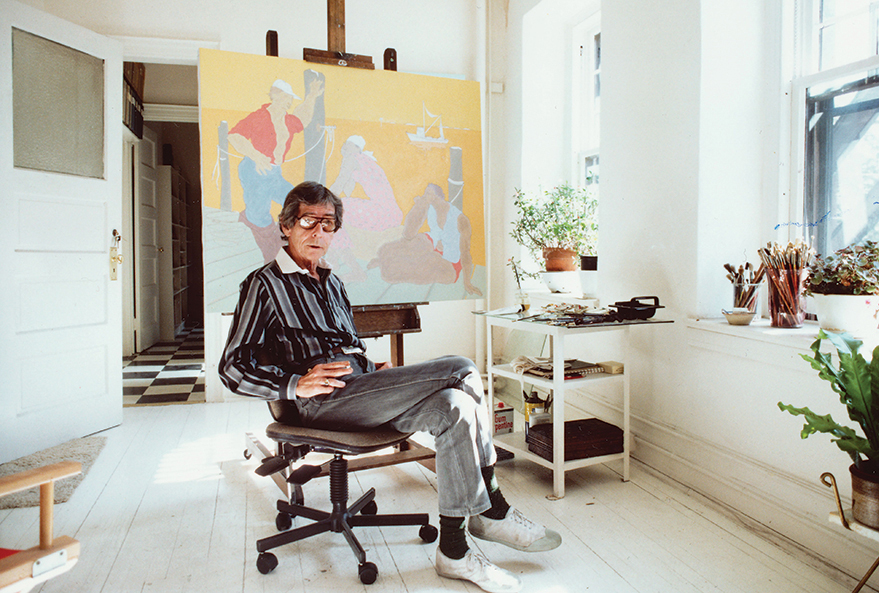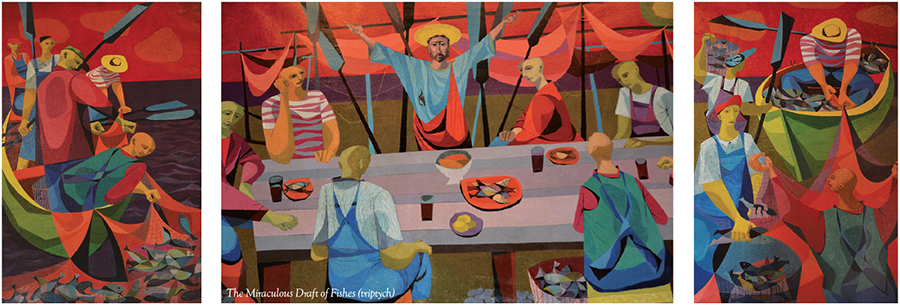Hidden in plain sight, a trio of surprising works of art by iconic Cape Fear artist Claude Howell are worthy of art pilgrimage
Story and Photographs by Virginia Holman
Many North Carolinians know Claude Howell (1915-1997) as one of Wilmington’s most notable artists. His visually complex, luminous paintings document life and work along the Carolina coast in such splendid works as Weeding Cabbage (1950), Ocracoke Fishermen (1956), and Mending Nets (1974). He was also a renowned storyteller and beloved commentator for WHQR radio.
Howell graduated from New Hanover High School in 1933, but due to the Great Depression and the death of his father, he did not attend college and never received a college degree. Instead, he worked until 1956 as a clerk with the Atlantic Coast Line Railroad. He handed the bulk of his paycheck over to his mother, Jessie, who took care of all of life’s mundane tasks like laundry and cooking so he could devote the remainder of his time to his art. According to Jan Kessler in Claude Howell, Carolina Interpreter, “This solution remained in effect until his mother’s death in 1972, when he was 57.”

Their arrangement helped Howell’s art career flourish. In 1953, despite his lack of a college degree, he was invited to found the department of art at Wilmington College, now UNC Wilmington. He began by teaching at night, one class a week after his job at the railroad. Soon, he was working two jobs — one at the railroad and one teaching four nights a week at the college — a situation that made it difficult for him to work on his art. In 1956, he accepted a full-time position at the college as the chair of the department and resigned from the railroad.
Howell took his role as a professor seriously. In a journal entry dated June 3, 1964, he wrote, “I thoroughly enjoy teaching, but because I do it gets extremely strenuous. I get quite involved and really fight to make these students better not only as artists but as people too.”
Howell’s unwavering devotion to his community is evident in several surprising places in the Cape Fear region. It’s well worth taking a weekend pilgrimage to view these remarkable works of art, each one a unique and valuable part of our history.
The evocative, color-saturated, 5-by-26-foot mural The Miraculous Draft of Fishes is located at Little Chapel on the Boardwalk (2 West Fayetteville St., Wrightsville Beach). I happened to visit the church on Ash Wednesday to photograph the painting, and several congregants stopped to chat with me as they left the midday service. One woman described the mural as “our great treasure.” Another fondly recalled her time as an art history student of Howell’s. Yet, when the painting was commissioned, there was a bit of controversy. In a journal entry dated December 1, 1951, Howell seems delighted that there “were absolutely no strings attached to the painting of the mural. Apparently, I can paint what I like.” By that spring, he had a vision in mind: a triptych “much more complicated than anything I have undertaken before.”

Although he was creating a work of religious art, Howell wanted to create something far from the “sickly sentimental type” of church art that he disliked. Instead, he aimed to “prove that modern art can be religious in feeling even more so than what we have in our churches today.”
Not everyone agreed. In April 1952, Howell wrote that “our Assistant Pastor . . . was sceptical (sic) about the whole business,” and said he “does not understand all this ‘modernistic stuff.’ Well, that is not all. He does not know who Michelangelo was. Can you imagine a minister not being familiar with the creator of the Sistine Chapel? I am becoming more and more interested in the early church and have discovered that we Presbyterians have ignored the first 1500 years of our church history. We assume that everything began with John Calvin.”
Even after the installation of the painting, it was not appreciated immediately by some in the community. Howell took a measure of comfort that everyone “who has any concept of painting has been enthusiastic, but they are certainly in the minority . . . I am insulted constantly . . . I tell them I care little what they think, that I did it for God and not for them.”
Eventually, members of the local Presbytery rallied. Howell’s journal recounts receipt of a copy of a letter from one “Mr. Dallas Herring of Rose Hill written to Dr. Taylor, a local Presbyterian minister, who said in part” that (although the mural) “is somewhat daring in design it has a special kind of beauty which strikes a responsive chord.” He then went on to add, “And I suppose as long as our theology remains conservative no one could blame the Presbytery for indulging in a little modern experimentation in art.”
Today, a visit to the Little Chapel on the Boardwalk reveals a visionary painting, a work of art that its congregants and visitors now hold dear.
A trip to Europe in 1949 left Howell feeling “overwhelmed by the mosaics in Ravenna . . . and dying to do one.” The two large mosaics he received commissions for in the Cape Fear region didn’t kill him, but they likely contributed to his sudden onset of paralysis in 1965. Several sources, including an entry in Howell’s journal that recounts his attending physician’s theory, indicate that the probable cause was some form of poisoning from his art materials.

The first mosaic was instigated by Howell’s friend Stanley South, who was the head archaeologist at the state historic site at Brunswick Town (8884 St. Phillips Road, SE in Winnabow). A new visitor’s center was scheduled for completion in 1964, and South helped Howell secure a commission to create a scene commemorating the historic 1748 Spanish attack on the village of Brunswick Town. Howell wanted to create a mosaic as exquisite as those he had seen in Italy, so he ordered Murano glass tesserae from a New York importer named Leo Popper. In his August 1964 journal entries, Howell wrote: “I cannot believe how beautiful the small glass enamel bits of color are. It is the most exciting and sensual color I have ever seen and I cannot wait to begin using it.”
Howell and his assistant, “the quite talented” Catherine Hendricksen, worked long days. “It is extremely slow work. If we stick to it steadily all day we can cover almost a square foot. But so often we get into small areas and then each piece of enamel has to be cut to fit.” Despite the tediousness of this work, and the fact that the glass shards were constantly cutting his fingers, he wrote that “I have never worked on anything I have enjoyed more.”
With Hendricksen’s help, the intricate, dazzling mosaic was completed in 1964. The bottom of the mosaic includes tiles highlighting Claude Howell’s name and 1964 and then, several feet away and small enough to be overlooked, are the initials CH — not his initials, but Catherine Hendricksen’s. According to Brunswick Town’s historic interpreter Shannon Walker, when Hendricksen tiled in her initials, she cleverly included a small shard of historic Delft earthenware pottery recovered at the Brunswick Town archaeology site.
Unfortunately, funding for the visitor’s center fell apart at the same time the mosaic was completed. It remained stored in a back room at the museum, its frame beginning to bow, for three years. The building was completed, and the mosaic was permanently installed, in 1967.
After he had completed Spanish Attack on Brunswick in December of 1964, he immediately began design work on another mosaic commissioned by the State Ports Authority (2508 Burnett Blvd.) in Wilmington. In March 1965, he wrote, “I have wanted for so long to have something really big, impressive, and important in Wilmington. I am particularly pleased it will be here” at the Port of Wilmington.
This untitled large abstract tile mosaic spans a wall two stories high. “There is a large stairway in front of the mural,” he wrote in his journal, “but it is very contemporary and I have decided to incorporate that in the design as the railing on the ship.” As visitors ascended the staircase, he wanted them to have a sense of climbing aboard a ship deck chock full of remarkable superstructure. Unlike the mosaic at Brunswick Town, Howell did not help assemble this mosaic. Rather, “the work was being executed by Italian craftsmen in New Jersey in 1-by -2-foot sections. Paper would be pasted over each section and numbered. It was then to be shipped to Wilmington and the installation would be done locally and finally the paper would be washed off the face revealing the mosaic.”

However, in August 1965, Claude Howell fell ill and suffered from significant paralysis for over a year. His working theory, recounted in Jan Kessler’s book, was that the chemicals in the grout used in the Brunswick Town mosaic had entered his bloodstream via the many cuts on his fingers. Howell’s journals indicate that his doctor also thought that some form of poisoning from his art materials was the likeliest culprit, despite the fact most of the standard tests of the day didn’t show heavy metal poisoning.
Although Howell’s body was ravaged, his mind remained sharp as ever. When he heard that the installation of his mosaic at the port was complete, he was determined to see it. In a 1987 WHQR radio commentary, Howell recalled how he convinced his cousin and a nurse to smuggle him out of the hospital and had them practically carry him into the building to inspect the mosaic.
“Employees of the shipping company saw me coming and were hovering together on the second-floor balcony to watch the dying artist coming to view his masterpiece. It was my greatest scene . . . I have always felt this had much to do with my recovery. I would always break into a broad grin whenever I recalled the day . . . and completely forgot to be sorry for myself.”
About two years after its onset, Howell recovered from his paralysis and retaught himself how to paint. He continued to teach at UNCW until 1980, and also taught in community settings after his retirement. “I’ve taught about two-thirds of the people in Wilmington,” he told Jan Kessler.
Claude Howell passed away in 1997.
Author and creative writing instructor Virginia Holman lives and writes in Carolina Beach.


